Lecture
Это продолжение увлекательной статьи про история компьютерных игр.
...
games Dan Dare: Pilot of the Future, Dune, Dune II, Cool Spot, Disney's Aladdin, The Jungle Book, Lion King, Toonstruck and Action Force, Command & Conquer series), and finally, Vortex Software (creator of Cyclone and Highway Encounter hits).
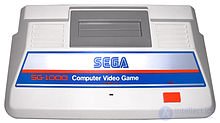
SEGA SG-1000
In 1983, SEGA released the SG-1000 game console (short for full name SEGA Game 1000). The prefix was first released for sale in 1981, but after trial sales of the first batch, the release of the console is postponed until 1983. In July 1983, mass sales of SG-1000 in Japan begin, but the prefix is not popular. Although the console belongs to the second generation of gaming systems, it is the most technically advanced of all consoles of its generation, and also has many of the characteristics of next-generation gaming consoles. Nevertheless, the prefix did not receive serious distribution and recognition of customers, mainly for the following reasons: the prefix was released at sunset of the second-generation consoles (although before the release of the first game console of the next generation); The SG-1000 hit the market in the midst of the video game industry crisis; The SC-3000 home computer produced by SEGA is fully compatible with the SG-1000, and the console has limited compatibility, which does not add to the popularity of the game console in the year of the explosion of the popularity of home computers. Nevertheless, SG-1000 is the first home game console of SEGA, and served as the basis for the creation of the next game console of the company.

Casio PV-1000
An attempt to enter the market of game consoles is undertaken by Casio. In October 1983, the Japanese company released the PV-1000 game console. Together with the console 15 cartridges with games were released. The success of the PV-1000 was not, a few weeks after the start of the sale were discontinued, and Casio itself was devastated by the filled retail store shelves.
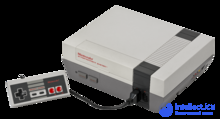
Nintendo Entertainment System
On June 15, Nintendo launches the Nintendo Family Computer (abbreviated as Famicom) in Japan. Nintendo has thoroughly approached the design of its first game console. Especially for Famicom, the Ricoh 2A03 CPU was developed, which is a processor core of the classic MOS 6502 with a built-in five-channel sound generator, a timer, an interrupt controller, a direct memory access controller, and input / output ports. Nintendo also used the RP2C02 video controller with a fairly advanced performance, specially developed by Ricoh. The console already at the start had an impressive library of games, and the advanced hardware allows you to create games with high quality graphics, animation, music and sound effects. The quality of even the first games for Famicom often exceeds the games for other popular home gaming systems of the time, including home computers. However, the height of the crisis, as well as the restrained criticism due to the low quality of the first revision of the game console, are the reasons for the extremely low sales of the console. As a result, Nintendo withdraws the console in 1984 and, after processing, re-launches the Family Computer for sale. This version of the console is selling so well that by the end of 1984, Famicom was becoming the best-selling game console in Japan. And next year, Nintendo renames the game console in the Nintendo Entertainment System (NES) and starts selling in the US (until 1986 in Japan, the console is sold under the brand Famicom), and a year later, sales start all over the world. NES becomes extremely popular and almost completely dominates the markets of the United States and Japan in the second half of the 80s. The Nintendo Entertainment System is still one of the most popular consoles — over 60 million gaming systems and more than 500 million gaming cartridges have been sold (excluding clones and pirated copies of games) [23] . The prefix was officially produced until 2003. In many countries, a large number of unofficial clones of the set-top box have spread. So in Russia, the unofficial version of the console called Dendy was very popular. It is with the release of the Nintendo Entertainment System that many analysts associate the end of the crisis of the video game industry and the revival of the gaming market [24] . The console started a new era of gaming consoles by opening the third generation of gaming systems.
Main article: 1984 in computer games
1984 begins joylessly for the video game industry. The crisis of the gaming industry continues, and many analysts doubt the future of the market, considering that the popularity of this kind of entertainment was nothing more than a fashion that has passed and will never return. The popularity of home gaming consoles is minimal. The golden age of arcade video games is nearing completion. True, games for computers remain popular, and the popularity of home personal computers continues to grow, but many analysts view the computer games market as secondary (the primary market is business software for home computers). Many companies remaining in the video game market suffer losses, including the recent market leader Atari (a division of Warner Communications Corporation).
But the home computer market continues to grow, primarily due to the continuous decline in prices for popular models. The pace is set by the company Commodore International is constantly reducing the prices of its popular home PCs Commodore 64 and VIC-20. Nevertheless, in January, “due to disagreement on basic issues,” Commodore founder Jack Tremel left the company. Soon, he founds a new company, Tramel Technology Ltd, to develop a new generation home computer. It should be noted that by that time many companies are already developing computers that should change the current generation of 8-bit machines. Moreover, many companies design personal computers based on 32-bit central processors at once, bypassing 16-bit microprocessors. Moreover, the first computer based on a 32-bit Motorola 68000 processor was announced by Apple even in 1983. And on January 4, Amiga Corporation (formerly known as Hi-Toro) demonstrated its prototype 32-bit multimedia computer - the famous animation “Boing”, which created a real sensation, and the company received much attention from industry participants.

Sinclair QL
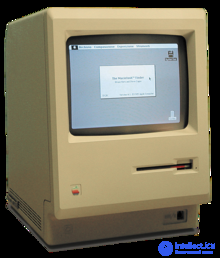
Apple Macintosh
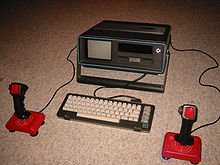
Commodore SX-64 - portable version of the famous Commodore 64
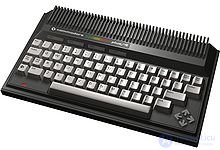
Commodore Plus / 4

Amstrad CPC
The first in the race of computers of the new generation is Sinclair Research. On January 12, it launches the first home computer on the 32-bit Sinclair QL architecture (short for Quantum Leap, the English word for quantum leap). Computer development began in 1981, but when Clive Sinclair learned that Apple was also preparing a computer on a 32-bit processor oriented for home use and small business, they made every effort to have time to release Sinclair QL before the Apple computer. Haste led to the fact that some of the functions of the computer contained errors, and the implementation of some simply had to be abandoned. Sinclair QL had a rather original architecture - the Motorola 68008 processor with 32-bit internal architecture used external 8-bit buses. The computer was conceived as the heir to the super-popular ZX Spectrum computer, however, for a number of reasons (among which many people called too early a release of a computer on the market), a commercial failure was expected for Sinclair QL. About 200 computer games were released for the computer, but the popularity of the machine as a gaming computer was almost zero. After that, Sinclair Research decided to abandon the development of this computer and focus on the line of 8-bit ZX Spectrum machines.
After just a few days after the release of Sinclair QL on January 24, Apple begins selling the first model of the Apple Macintosh line of personal computers. The first model of a ruler known as Macintosh 128K favorably differed from other computer systems. This model was the first computer where absolutely all user interaction occurred using a graphical interface and a mouse (in truth, similar developments were present among other computer manufacturers, but such computers were never massive, and control over the mouse was transmitted only in some programs ). The Macintosh 128K was a fairly successful model - in the first six months of sales, about 70 thousand machines were realized. The computer was very popular in the business environment, but the relatively high price ($ 2,495) did not contribute to the distribution of the line as a home computer. Nevertheless, the Macintosh 128K became the first computer of the very popular Macintosh line, which still exists under the Mac name. A large number of games were released for the computer, and the advanced graphics system of Mac-machines allows some developers to create unique game projects. Until now, Mac computers are among other things a gaming system with a large army of users.
Seeing that the first computers of the new generation are already entering the market, Jack Tremel is looking for a company that is already close to completing the development of a new generation home computer. Fortunately, Warner Communications has been looking for a buyer for its unprofitable division of Atari for a long time. In July, the companies reach an agreement and Tramel Technology absorbs Atari Inc. Almost immediately, Tramel Technology Ltd is renamed Atari Corporation, so Atari is reborn in a new capacity.
In the walls of the Atari, meanwhile, work on designing a computer on a 32-bit Motorola 68000 processor ends. However, Tramel pays attention to the development of Amiga (formerly known as Hi-Toro). The new computer is also based on the Motorola 68000, however, the characteristics of the Amori developed by the Amiga team of the Lorraine chipset are a cut above the similar set of Atari chips. At that time, Amiga was experiencing serious financial difficulties and Atari is making financial investments in Amiga to complete the development under the condition of exclusive use of the Lorraine chipset in future Atari products (game consoles and personal computers) instead of their own developments. Tremel trying to completely subjugate Amiga is delaying payments, suggesting that Amiga is facing serious problems with financing and will be ready for any agreements with Atari. However, instead, Amiga is looking for a new sponsor, and finds it in the face of Commodore International. Commodore is also delighted with Amiga's development and fully covers Amiga’s debts to Atari, and also buys the company to complete work on a new Amiga computer under the Commodore brand. Atari’s trial attempts, which bought the rights to the exclusive use of the Lorraine chipset that year, did not succeed, because Atari itself did not fulfill the obligation to pay cash in favor of Amiga. Thus, Atari had to return to developing its own version of a 32-bit gaming computer.
Of the other successful computers worth noting a new model of personal computer from IBM released this year. And although IBM PC / AT did not become a popular home computer, and even more popular gaming computer, the model nevertheless became the first serious development of the line of IBM PC compatible machines and was quite popular as an office computer. IBM PC / AT was the first fully 16-bit machine from IBM PC-compatible machines (previously 16-bit IBM PCs used 8-bit data buses and expansion slots). However, the widespread adoption of IBM PC / AT and its compatible machines provoked the release of a large number of gaming applications for these machines, and the platform itself eventually became one of the most popular gaming platforms in the world.
Do not think that 1984 was a turning point in the transition from 8-bit gaming systems. For a long time, 8-bit gaming systems (both home computers and game consoles) remained the most popular. Moreover, the market until the 90s was actively replenished with new models of 8-bit gaming systems. So, the Commodore company released two new computers in 1984. The Commodore SX-64 is a portable version of the Commodore 64 and the Commodore Plus / 4 is a new line of 8-bit Commodore computers. Both sales models failed completely. Commodore SX-64 due to the relatively high price and dubious mobility, and Commodore Plus / 4 has caused rejection of customers in the main lack of compatibility with the Commodore 64.
In the same year, another British electronics manufacturer, Amstrad, launched its 8-bit home computer, Amstrad CPC. The computer unexpectedly found a place on the seemingly already busy market of personal home computers. The CPC line was quite successful, for all time about 3 million devices (not counting clones and compatible machines) were sold. The wide distribution and fairly good graphics and sound capabilities of the system have attracted the attention of many manufacturers of computer games. CPC has long been popular with players, and CPC compatible machines have long been a popular gaming platform.
In 1984, changes in the computer games market were fully manifested. If earlier the best games were played on arcade machines and only later were transferred to home gaming systems, now the popularity of gaming machines is greatly reduced. Most of the original video games come out for home computers. At this time, the sunset of the so-called golden age of arcade video games falls. Nevertheless, arcades continue to be popular, and although not a single arcade machine released since then has been able to outperform classic arcade games, nevertheless, a large number of new automata are released and, accordingly, many new interesting games.
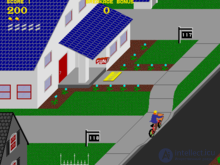
Paperboy
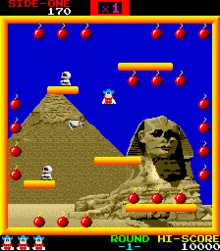
Bomb jack

Circus charlie
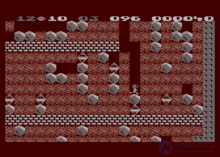
Boulder dash
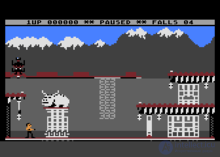
Bruce lee
Karateka
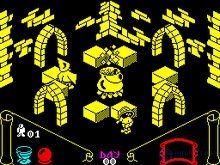
Knight lore
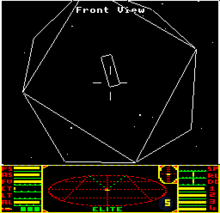
Elite

Jet set willy
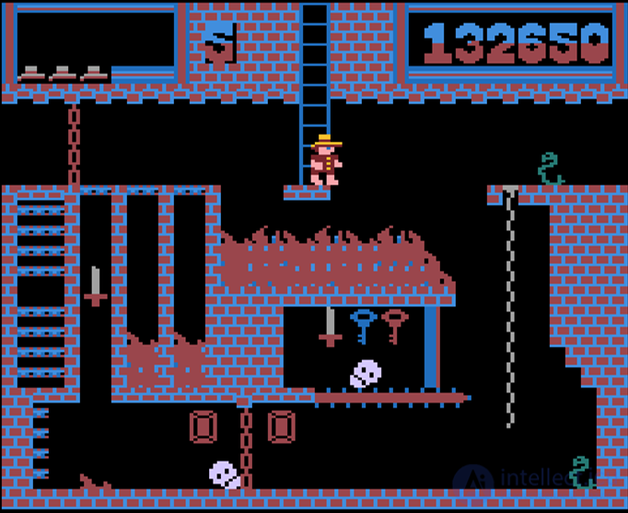
Montezuma's Revenge
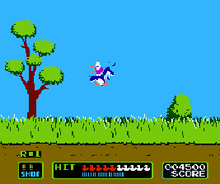
Duck hunt
For example, Atari launches the Paperboy arcade machine. The game is a success, but the main popularity comes with the release of the game for home computers, and later for game consoles of the new generation. The simple gameplay of delivering newspapers across a residential area was quite fascinating and received good reviews from both users and critics. Versions for gaming computers have been repeatedly awarded (for example, UK number-one Spectrum game - January 1987). The game was continued with the release of the sequel. Another popular arcade from Atari was the game Marble Madness, which formed a new non-standard genre of video games. The elaborate game mechanics and non-standard gameplay attracted the attention of a large number of fans. Traditionally, the game has been re-released for many home gaming systems.
Capcom launches its first hit - the game 1942. This game became one of the most popular arcade machines in 1984 and made Capcom a leader in the gaming arcade entertainment providers. 1942 was the first game in the successful 19xx video game series. Vertical scrolling shooter gained popularity not only as an arcade machine, but also in versions for home computers and game consoles. The game is still a success and is reissued for modern gaming platforms.
Namco continues the Pac-Man theme and launches the Pac-Land slot machine. It is interesting that the game was created not based on the original game, but based on the animated series. As a result, Pac-Land gameplay is completely different from the games of the main line and is a platformer. Nevertheless, the gaming machine was popular, although it could not even come close to the level of popularity of the first Pac-Man. Like many popular games of the time, Pac-Land was reissued for most of the popular home gaming systems.
Unexpectedly, Tehkan (today known as Tecmo) announced itself with the release of the Bomb Jack arcade machine. The machine was very popular, which traditionally led to the creation of versions of the game for home gaming platforms, where the game was greeted with even greater success. Versions of the game for home computers were often among the bestsellers.
Konami was noted for the Circus Charlie slot machine. The game is an arcade platformer with a simple but fun gameplay. As a result, the machine gun, where the player is going to perform dangerous stunts as a circus clown, became very popular, and the game itself was later ported to many 8-bit gaming systems. The game is part of the classic arcade game Konami. [25]
Nintendo has released several arcade machines this year. In February, the punch-out gaming machine was released !!. It was the first arcade boxing simulator game and the first gaming machine with two monitors. Punch-out !! became one of the most popular Nintendo video games and soon received a sequel in the form of the Super Punch-Out game !! and spin-off of Arm Wrestling. Based on Punch-out !! games for consoles and home computers were released - Punch-Out !!, Mike Tyson's Punch-Out !!, Super Punch-Out !!, Frank Bruno's Boxing, Frank Bruno's World Championship Boxing and others. The last game of the Punch-Out series !! was released in 2009 for the Nintendo Wii game console. Except Punch-Out !! in 1984, Nintendo released the third game of the Donkey Kong series, which offered a completely new gameplay compared to other games of the series and received mixed reviews from critics and low-key popularity among players. The game, although considered to be commercially successful, but its popularity is significantly lower than in other games of the Donkey Kong series.
In the wake of Dragon's Lair's success, Cinematronics is launching a new Laserdisc game Space Ace. Like Dragon's Lair, the new game was distinguished by the quality of animation at the level of the best animated movies. Excellent animation was also performed by Don Bluth. The gameplay as a whole remained the same - the player needed to make a movement with a joystick at a certain point or press a certain button in order to correctly play a previously recorded episode of an animated film. But there were innovations. So some scenes could be completed in various ways - for this, several animated episodes were created. The game, like its predecessor, was met quite well and was popular, although it could not surpass the popularity of Dragon's Lair.
It is also interesting that this year Atari launches two universal expandable arcade platforms, the Atari System 1 and the Atari System 2. Unlike the classic arcade machines that were created for a particular game, the Atari System platforms performed the game recorded on a cartridge. This made it possible to simplify the creation of games for arcade machines and regulate the variety of games in the gaming salon, depending on their popularity. So, the Marble Madness game mentioned above was released for Atari System 1, and Paperboy for Atari System 2. A similar approach to creating arcade machines (as universal platforms) was used by Data East since 1980 - it created the first unified system DECO Cassette System . Later, the Taito SJ System from Taito (1981) and Sega System 1 from Sega (1983) appeared, but they had just the same platform for several games, and were released as separate single-game gaming machines. Atari System was the first arcade platform with interchangeable games from a major player in the market. Later, almost all manufacturers of arcade machines have released similar unified systems. Nevertheless, for a long time there were attempts to create a unique gaming machine for which a special hardware platform was developed.
Influenced by the popularity of home computers continue to create new gaming studios. So in 1984, one of the founders of Activision, Alan Miller (Alan Miller) and Bob Whitehead (Bob Whitehead) create a new company Accolade. The studio produced games for a wide range of gaming platforms, for almost all popular gaming consoles and home computers. Accolade has released and published many popular games that have become hits. Of the most successful games worth noting are the Grand Prix Circuit and Turrican games, as well as the Test Drive, Star Control, Bubsy, HardBall! Game series.
In the same year, the publishing company Elite Systems was founded, which was mainly engaged in porting popular games from arcade machines (less often than other gaming platforms) to home gaming systems (mainly home computers) and publishing them under their own label. In addition, the company published games of independent developers and small game studios. The company enjoyed a good reputation among the players, and was also repeatedly awarded with game publications for high-quality ported versions of popular games and as a publisher of popular games.
Another game studio created this year is Gremlin Graphics - a well-known developer and publisher of computer games. Under the brand Gremlin came a lot of popular games (the famous Dark Fusion, Jungle Strike, Fatal Racing) and several well-known game series (the Monty Mole series), the series of the famous Lotus and Top Gear racing simulators. Games by the company Telecomsoft, also formed in 1984, were no less popular. The company released games under the brands Firebird, Silverbird and Rainbird. The popular games Don't Panic, Booty, Chimera were developed in the depths of Telecomsoft. In addition, the company was a major game publisher.
Ocean Software is another developer and publisher of computer games based this year. The company was engaged in the development of its original games, but it gained particular fame as a developer of high-quality games based on movie licenses, as well as versions of games for home computers from arcade machines licensed by Konami, Taito and Data East. In addition, the company acted as a publisher of games from third-party studios. Ocean games have repeatedly won awards from authoritative publications (including the winner of the 1988 Golden Joystick Awards as the best game developer for 8-bit systems [26] ). A series of games about the Adams family, the adventures of Batman, the video games of the Rambo series, the RoboCop series of games, the Chase HQ series invariably turned out to be among the best-sellers. Cobra, Cool World, Dennis The Menace, Eek the Cat, The Flintstones, Highlander, Hook, Sleepwalker, Jurassic Park, Miami Vice, Platoon, Short Circuit, Total Recall, The Untouchables, Cabal, Cheesy, F29 Retaliator, Head Over Heels, Kid Chaos, Operation Wolf, Operation Thunderbolt, Rainbow Islands, The NewZealand Story.
Similarly, the US Gold company formed in the same year worked. Despite the name, the company was based in Great Britain and was engaged in the publication of computer games of its own and third-party production. US Gold developed original games, as well as versions for home computers of successful games with arcade machines and other gaming systems. The games of the company were popular with the players and were well received by critics. Games of the company have repeatedly received awards from authoritative publications (including the winner of the 1988 Golden Joystick Awards in the nominations for the best game developer and the best game of the year [27] ).
A large number of studios for the production of games for home computers naturally leads to the appearance of a large number of original video games. Some projects surprise with their originality. So Mel Croucher (Mel Croucher) creates for the company Automata UK the game Deus Ex Machina (the original ZX Spectrum platform). The game was met with great interest by critics and received positive reviews, however, the publishers considered the project risky and refused to distribute Deus Ex Machina. Automata UK faced a non-banal situation. The game was well received by critics, the preliminary demand from the buyers was good, but there was not a single publisher who took up the distribution of the game. As a result, Deus Ex Machina distributed exclusively by mail orders. Automata UK performed work with mail distribution independently. A complex distribution system leads to a large number of pirated copies of this game, however the game brings commercial profit. Deus Ex Machina, despite the difficulties, is becoming widespread and is a success, and Automata UK, in the wake of the popularity of the game, releases versions for other 8-bit systems of the time. The game is included in the book 1001 game in which you must play before you die (1001 Video Games You Must Play Before You Die) [28] . Despite the free availability of the game, the unusual gameplay and mainly pirated distribution made the game an object of underground art.
Established in 1982, the George Lucas game studio Lucasfilm Games is surprisingly surprising with two projects. A game unit created to develop the games of the Star Wars and Indiana Jones universes in March 1984 produces two original games that have become classics. Rescue on Fractalus! and Ballblazer for 8-bit Atari and Atari 5200 computers, which were unexpectedly popular and most successful studio projects of the time. High-quality technical implementation and dynamic gameplay changed the standard idea of video games for home gaming systems - both games used a first-person view, with different smooth movements and high dynamics. The game Rescue on Fractalus! Uses the technology of displaying fractal objects to create mountain landscapes of a distant planet on which the player performs a search and rescue operation. The first-person view (from the cabin of the spacecraft) increases the depth of immersion in the gameplay, and the constant exchange of fire with enemy ships maintains a high dynamics of the gameplay. The game Ballblazer is a futuristic sports game, something like one-on-one football on the cards. The game also differs from the first person view (from the cabin map) and high dynamics of action. The popularity of games prompted the company to release games for other popular gaming systems of the time, where they also enjoyed deserved success. The triumph of these games became the first great success for Lucasfilm Games, and the studio itself has proved itself not only as a producer of games based on the parent company's kinolitsenziyami, but also as a serious player in the video game market, producing successful original games.
Special mention deserves the game Boulder Dash (published by First Star Software in 1984 for 8-bit Atari computers). The game about the underground adventures of the treasure hunter Roquefort became so popular that it was re-released for other gaming platforms of the time, and even for arcade game machines, that it was nevertheless rare. Более того, игра сначала была адаптирована под игровой автомат компании Exidy, а позже была выпущена улучшенная версия для DECO Cassette Systemкомпанией Data East. Таким образом Boulder Dash стала тем редким случаем, когда версии одной и той же игры были разработаны не только для разных платформ домашних игровых систем, но и разных платформ аркадных автоматов. Игра дала начало целой серии игр Boulder Dash. Новые игры этой серии продолжают выпускаться по сей день.
Still unpopular in computer games, the genre Beat 'em up suddenly received close attention from the players after Datasoft released Bruce Lee for 8-bit Atari computers. An interesting fact is that for the first time for the popular game the antagonist is a real person (Bruce Lee). The game is a mixture of platformer and Beat 'em up. At the same time, it cannot be said that the mechanics of the platformer or the Beat 'em up component has a great depth of study - both elements have fairly simple mechanics. Nevertheless, in general, the gameplay was simple, clear and fun, and the game received good reviews from critics and great popularity among players. Soon there were versions of the game for other popular gaming computers of the time: Commodore 64, ZX Spectrum, Amstrad CPC, MSX, BBC Micro, Apple II, NEC PC-8801 and IBM PC-compatible computers.
A significant contribution to the popularization of the genre Beat 'em up was made by the game Karateka, released this year by Brøderbund. Released for Apple II, the game becomes a bestseller and soon released versions for other gaming systems. Karateka was very well received by both players and critics. First of all, the realistic and smooth animation of characters was different from other games. To create such an effect, the author of the game, Jordan Mehner, used rotoscoping technology for the first time for computer games. In the future, this method of creating computer animation was used in many games. The game remains popular to this day, and its modern remake has been well received by critics and players. Karateka has undoubtedly made a significant contribution to the popularization of Beat 'em up games, as well as to the development of computer animation.
For the ZX Spectrum, Vortex Software has released Costa Tornado Low Level (also known as TLL). The game was very popular and was re-released for Amstrad CPC. The success of the game allowed the author to continue the development of computer games and implement even more successful game projects. In the list of the 100 best games of all time of the magazine Your Sinclair, the game ranks 10th [29] .
In Japan, Nihon Falcom launches the Dragon Slayer game for the NEC PC-8801 computer. The game enjoyed a well-deserved popularity, but real success came after the company Square released a version of the game for computers MSX. Action / RPG game suddenly turned out to be the most popular game in the Japanese market. Moreover, Dragon Slayer has a high historical value, as it is the founder of two new genres of video games: JRPG and Action / RPG [30] [31] [32] . The game served as a start for the successful game series Dragon Slayer, as well as the Xanadu and The Legend of Heroes games. Games of these series were released for many game consoles and enjoyed a well-deserved success outside of Japan. The classic Dragon Slayer games have been released for eleven years, and the Legend of Heroes series remains popular and is being updated with new games to this day.
Under the Ultimate Play The Game brand in 1984, the first three games of the popular Sabreman series were released. The games of the series were originally created for the ZX Spectrum, but later, due to the exceptional popularity of the games, they were transferred to the BBC Micro, Amstrad CPC, Commodore 64 and MSX platforms. The games of the series have become a serious development of the Action-adventure genre. The first game of the Saber Wulf series was an unexpected success for the publisher - the game’s sales exceeded one million copies [33] . The game takes 11th place in the list of the 50 best games of all time according to Your Sinclair [34] . The second game of the Underwurlde series enjoyed the expected success of the players, and Your Sinclair put the game in 17th place in its list of the 50 best games of all time. And finally, the third game - Knight Lore was not only the most successful game of the series, but also the first game on the Filmation engine. As a result, the game became the first isometric adventure game. Knight Lore made a breakthrough in the genre of Action-adventure games, and sales of the game exceeded other games in the series. Knight Lore became the game of the year Golden Joystick Award [35] , and in the list of the top 50 games of all time Your Sinclair placed the game in second place and called the game "one of the most important (and best) games ever written for Speccy" (one of the most important (and best) games ever written for the Speccy).
Action-adventure genre is becoming very popular on home gaming computers. So for the ZX Spectrum comes the game Pajamarama, which becomes the game of the month according to the popular magazine Personal Computer Games (Game of the Month award November 1984). Pajamarama is the first game of the Wally Week series of games where Wally himself is the main character of the game (and the second game of the series). The Wally Week game series itself was very popular on home computers and was released for the ZX Spectrum, Amstrad CPC and Commodore 64 computers. Another very popular game of the Action-adventure genre released this year was Tir Na Nog. Released for the ZX Spectrum and Amstrad CPC, the game was soon ported to the Commodore 64. Based on Irish mythology, Tir Na Nog was enthusiastically greeted by critics for the new level of technology presented on 8-bit platforms (primarily a large maze attracted attention, animated background and parallax scrolling ( eng. )). The game was popular among players and a year later it was developed as a prequel of the game Dun Darach.
By the way, the technical implementation of many games has grown significantly. Game developers have learned how to optimally use the resources of 8-bit computers. So Micromega released for the ZX Spectrum a new racing simulator Full Throttle. For the high-quality implementation of the motorcycle simulator, the game has collected a large number of rave reviews from critics. Many authoritative magazines called Full Throttle the best motorcycle racing simulator, and also noted that the implementation of the roadway surpassed even arcade machines, including the classic Pole Position [36] [37] [38] [39] . It is not surprising that the game was very popular among players, including after the release of the version for MSX computers.
Special mention deserves the graphic adventure game Enchanted Scepters. Although she cannot boast of great popularity, she is nevertheless remarkable for others. Enchanted Scepters was released for the new Apple Macintosh computer and fully used the new graphical user interface with the player. To search for and use items, the player needed to use the mouse. Thus, Enchanted Scepters was the first quest with Point-and-click management.
It is impossible not to talk about another game that saw the light in 1984. Acornsoft has released the Elite game developed for the BBC Micro by David Braben and Jan Bell. In the same year, a version for Acorn Electron was released. The game has become a real event. Many publications have called Elite a real breakthrough and assigned the title of the game of the month [40] . Such a hot reception was not unreasonable, - Elite was built on the principle of absolute nonlinearity and complete freedom of action of the player, and created a new computer game genre of space trading simulator [41] . The game was reprinted on many gaming platforms, and also has several sequels. Elite was very popular with players, and even today, remakes of the classic game are a success [42] . Moreover, many trading space simulators are called Elite-like games. The publication of the Times in 2007 put the game in third place in the list of ten games that had the greatest impact [43] .
A significant event was the release for the ZX Spectrum game Rebelstar Raiders. Julian Gollop created a turn-based tactic game that became so popular that it was the beginning of a series of Rebelstar games. Rebelstar Raiders was a big step in the development of the genre. The author himself subsequently developed the ideas laid out in Rebelstar, first creating the Laser Squad, and then the well-known X-COM series [44] . Games of the Rebelstar series are repeatedly included in the lists of the best games, both in the opinion of critics and the players themselves.
The game Spy vs. stood out with a very original gameplay. Spy developed by First Star Software based on the MAD Magazine comics series of the same name. The comic game about two spies trying to kill each other in the most unusual ways became very popular with players, was well received by critics for the innovativeness of the gameplay, won many awards and became a bestseller [45] . Spy vs. Spy was released for a large number of gaming platforms (for home and office personal computers, game consoles, cell phones and tablet PCs).
In the same year, Raid over Moscow was developed by Access Software and distributed by US Gold. A game released in the midst of the Cold War was a phased mission to stop a nuclear attack on the United States by the USSR. Each stage was a unique mini-game, which greatly varied the gameplay. What is in tandem with the current theme made the game popular with players and earned praise from reviewers. Raid over Moscow went down in history also produced a socio-political effect, mainly in Finland. Immediately after the release, the game received high marks in magazines, for which the left-oriented newspaper Tiedonantaja (Finland) published an article condemning the high ratings of the game and called for a ban on selling the Soviet games and Raid over Moscow in the first place. The discussion reached the level of the government of Finland and official representatives of the USSR in Finland. The situation was aggravated after the release of the petition demanding a ban on the distribution of books, magazines and other media discrediting the image of the Soviet Union in the public eye. On the other hand, the laws of this country did not allow prohibiting the import of a product if it does not harm the health (directly or indirectly). The case ended with a public apology from the Minister for Foreign Affairs of Finland for publishing in the mass media articles defaming the image of the USSR and confirming the friendly relations between the countries [46] . By the way, for the period of the debate Raid over Moscow turned out to be the best-selling game in Finland from March to September 1985 [47] It is fair to say that despite the high popularity of the game in other countries, there were also notes of protest against the spread of this game [48] [ 49] . In the USSR, the game got into the list of anti-Soviet military propaganda.
In 1984, the platformer became a very popular genre. A lot of new games are coming out, many of which have become very popular and have given a serious development to the genre as a whole. So, for the Commodore 64 Epyx company releases the game Impossible Mission. Platformer has a very high-quality and technical execution, which as a result made the game one of the most popular for the Commodore 64 platform. So ZZap! 64 magazine put the game on the second place in the list of the best games for Commodore 64, while in the opinion of readers Impossible Mission took first place in the list [50] . Subsequently, the game was ported to a large number of gaming systems, as well as received a continuation after the release of sequels.
For the ZX Spectrum several platformers appear. The most popular games are Wanted: Monty Mole and Jet Set Willy. Wanted: Monty Mole became one of the most popular platform games and was soon ported to the Commodore 64. The game marked the beginning of a successful series of six games about the adventures of the mole Monty. In the list of Your Sinclair 50 best games of all time, the game is listed in 15th place. However, Matthew Smith, a platformer about the adventures of the miner Willie, was even more successful. For nine weeks, Jet Set Willy was the best-selling game in the UK [51] , and was also very popular all over the world. Sales of the game exceeded a million copies, which at that time was very rare. Your Sinclair in its list of the 50 best games of all time put Jet Set Willy in sixth place. The popularity of the platformer stepped over the native platform - the game was ported to a huge number of other gaming systems. Jet Set Willy is considered to be a classic game for the ZX Spectrum.
The Atari 400/800 platform also acquired an original and very popular platformer. Montezuma's Revenge game has become a hit. The adventures of the treasure seeker Panama Joe in the pyramid of the 16th century Aztec Emperor Montezuma II was one of the most popular games of the Atari platform. As a result, the publisher of the game, Parker Brothers, soon released the game for many other gaming platforms of the time, and an even larger army of players continued to master the rich treasury under the Curacic tune. Interestingly, for some platforms, the game exists even in several versions. For example, the native platform Atari 400/800 has two slightly different versions of the game: the actual Montezuma's Revenge itself and Preliminary Monty. Similarly, for the ZX Spectrum platform, the game is found in different versions of the implementation under the names of Panama Joe and Preliminary Monty.
Do not think that the range of home gaming systems is limited only by personal computers. Despite the fact that in the camp of game consoles continues the crisis, however, the army of owners of gaming consoles has reached a truly huge size. So, in seven years, the number of Atari 2600 sold has reached the mark of 30 million copies. And this means that the game released for this platform has 30 million potential buyers. Thus, games for consoles continue to be created. For example, the company Activision released in 1984 for the console Atari 2600 game HERO. The game became very popular on its native platform, but soon it felt like a hero of Roderick (Roderick Hero or just R.Hero) - a rescue team of one person, players of other platforms could. Activision ported the game to a number of other gaming systems of the time, while HERO enjoyed great success everywhere.
As already mentioned, despite the decline of the second generation of game consoles and the protracted crisis, the Atari 2600 console remains the most popular home gaming platform. It is not surprising that the fashion for platformers has not bypassed this game console. Activision launches the new Pitfall II: Lost Caverns game by David Crane. Like the original, the second part of Harry Pitfall's adventures was a real event on the original platform. The game literally surpassed the console. Especially for this game, David Crane has developed an additional sound processor that was embedded in the game cartridge and significantly improved the musical characteristics of the game console. Pitfall II was the first game that used an additional co-processor in the cartridge to improve the technical characteristics of the gaming system. Nevertheless, the experience was quite successful, and, subsequently, more than once will be used in video games. And some game consoles will initially support the ability to install an additional coprocessor. However, not only the unique technical solution of the game went down in history. Fascinating gameplay made the game extremely popular. Retro Gamer magazine in the list of 25 best games for the Atari 2600 put Pitfall II in the first place [52] . The game was traditionally ported to other popular gaming systems. Moreover, the company Sega licensed the game and released it as an arcade machine. Today the game is considered a classic platformer genre.
Well, it is impossible not to note the creation of the Tetris game by Alexey Pajitnov. Within the walls of the USSR Academy of Sciences, one of the most popular games in the world was created, which became a cult, and, naturally, the most popular computer game created in the USSR. For the right to publish Tetris outside the Iron Curtain, the world's largest corporations were replicated: Atari Games, Nintendo and Robert Maxwell's media empire. The resolution of the dispute was accompanied by several lawsuits and special negotiations at the level of the government of Great Britain and the USSR. The game itself, as a result, became one of the most popular computer games in the world, was represented on almost all gaming platforms and had a great influence on the development of so-called casual video games. Moreover, Tetris is the only game that has stepped over 100 million sales. Under this name, about 143 million copies of video games were sold, which is an absolute record [53] . Tetris influenced contemporary culture, and references to the game are often found in contemporary art, animation, movies, and other cultural works.
For gaming consoles came not so many original computer games. Being just recently the driving force of the video entertainment industry, game consoles are now aloof from major events. Almost all the games that are released for consoles this year are either ports from personal computers, or adaptation of games from arcade machines. Original games for consoles are almost never released. All the more surprising is the appearance of the Duck Hunt game on the Nintendo Entertainment System this year. This exclusive for NES suddenly turns out to be one of the most popular games of the year. Duck Hunt for all time has sold over 28 million copies, which makes the game one of the most popular games for the third-generation consoles, and the second best-selling game on the Nintendo Entertainment System [54] . The game had such high popularity that it was often clearly associated with the game console itself, and also received the status of a cult [55] .
The segment of home gaming computers and computer games is booming. In the sector of game consoles, a complete lull - the crisis of the video game industry continues, sales of consoles are at a minimum, almost zero level. The total income of the industry is reduced tenfold. Nevertheless, many companies continue to hope for a market recovery. Atari is trying to revive the market for home gaming consoles. Replacing the unsuccessful model Atari 5200 is preparing to release a new game console, and on May 21, the Atari 7800 announcement was held at the Consumer Electronics Show [56] . However, the sale of the company (in July, Atari was taken over by Tramel Technology) postponed the start of sales of the new console for another couple of years. Nevertheless, the announcement of the prefix from the former leader aroused the interest of both the press and the end players, which ultimately gave hope for the end of the crisis.
A similar attempt is being made by SEGA. In July, the company replaces the SG-1000 console with the release of an updated SG-1000 II model. Despite the obvious improvements and corrections of some of the shortcomings of the first console, the model numbered II was never able to outperform the SEGA SC-3000 home computer. The updated game console has not achieved significant success in the market.
For Nintendo, the year is a little different. Released last year, Nintendo Famicom almost collapsed in the market and the company recalls the product. A revised version of the console was released in Japan in the same year under the same name. Updated Famicom awaits unexpected success, the popularity of the console was like an explosion. By the end of the calendar year, more than 2.5 million copies were sold in Japan. Japan has not yet known such a high level of sales of game consoles. Along with consoles, cartridges with games were actively sold. At the end of the year, almost all analysts said the end of the crisis of computer games in Japan and a clear recovery of the situation. In general, this event gave hope for the imminent end of the crisis around the world.
Main article: 1985 in computer games
Since 1985, business analysts have pinned serious hopes. And although the global crisis of the video game industry was still going on, the Japanese market had fully recovered by that time. Moreover, the market for gaming consoles on the territory of this country has even increased. And unlike the rest of the world, in Japan, third-generation gaming systems were confidently leading in sales. Therefore, the chances for the revival of other major gaming consoles markets - North American and European, and the world market as a whole were rated quite high.
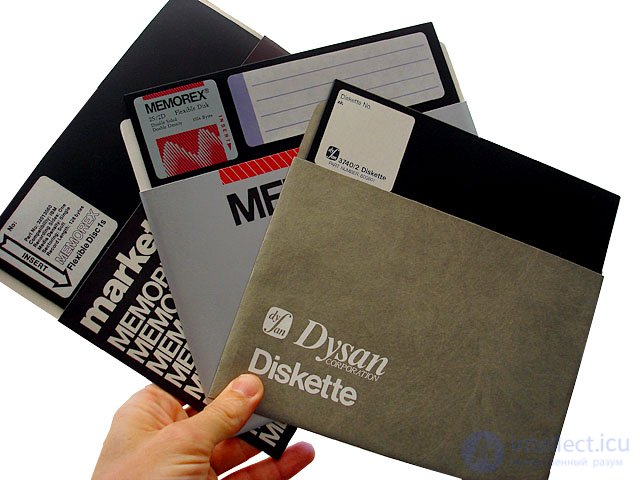
3½ inch diskette
However, the main gaming platform of the time remain 8-bit home computers. Personal computers are not as convenient game systems as, for example, game consoles. Nevertheless, 8-bit home computers — devices that are more functional and fairly cheap — remain very popular. All this leads to the emergence of new models of popular gaming PCs. Interestingly, for all personal computers, around this time there is a change in the format of the media. Until this year, programs for personal computers (gaming, system, office and other) were published on various media. So, not very convenient, but very affordable and cheap audio compact cassettes used as a carrier as a carrier, although cartridges, 8-inch floppy disks and floppy disks of 5¼-inch format were also used. In some cases, more exotic devices were used, such as micro cassettes or gramoplates, and Sinclair Research’s computers used the ZX Microdrive in addition to standard audio compact tapes. However, a consortium of 21 companies decided to create a new single standard floppy disk, while cheaper, reliable, compact and convenient than existing media. As a result, in 1983, the so-called Microfloppy was created - a 3½-inch floppy disk. True to 1985, this format was not widely used. The only popular computer that used Microfloppy as the primary storage medium was the AppleMacintosh 128K. True, the experience was very successful, floppy disks have proven themselves well, and all computers that appear in 1985 already suggest using 3½-inch floppy disks as an additional or even primary means of information storage. Moreover, until the mid-90s, namely 3½-inch floppy disks remained the main means of software distribution, including computer games.
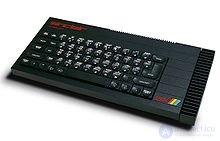
Sinclair ZX Spectrum 128
As already mentioned, 8-bit home computers remain the most popular gaming platform. However, the reduction in the cost of memory chips and the emergence of new information storage media are pushing manufacturers to update the lines of existing PCs. So the company Sinclair Research suffered a complete fiasco with its new 32-bit computer Sinclair QL focused on the development of the popular line ZX Spectrum. True, the new Spectrum models released before 1985 differed mainly in the new device case. But at the SIMO'85 exhibition, Sinclair Research presents a truly new ZX Spectrum 128 model developed jointly with the Spanish distributor Investronica. In the same year, the company began selling computers in Spain. Interestingly, because of the fact that warehouses are full of old models in the UK, they only saw a new computer in 1986. However, the new features of the model, primarily 128K RAM (instead of 48K for the old ones) and the presence of a three-channel MIDI-compatible sound controller, make the new model very popular. Many gaming studios are launching the release of games for two models: the classic ZX Spectrum 48 and the new ZX Spectrum 128. Some manufacturers initiate the release of old popular games for an updated platform. With this update, the model range ZX Spectrum for a long time remains a popular gaming platform.

Commodore 128
Having failed with the release of new models of 8-bit computers in 1984, Commodore Business Machines declined to create a successor to the super-popular Commodore 64 very thoroughly. Commodore 64 in the eyes of consumers had almost no flaws, however, it was almost completely redesigned. By the mid-80s, the most popular operating system on 8-bit PCs is clearly CP / M. Unfortunately, this OS only works on processors with the 8080 command system, and Commodore 64 does not support the MOS 6510 CP / M as a central processor. To solve this problem, the new Commodore 128 is equipped with two central processors MOS 8502 and Zilog Z80A. At the same time, the MOS 8502 processor had two operating modes: full compatibility mode with the “old” MOS 6510 and full speed mode. The new computer also contained two graphics processors: the new and very advanced MOS Technology 8563 and the old MOS Technology VIC-II for compatibility with the Commodore 64. In general, the computer received several new ports for connecting peripheral devices, an updated case, expanded to 128 KB, and to ensure operation in various modes, it contained several firmware in a rather impressive 72 Kilobyte ROM. Undoubtedly, the new Commodore Business Machines machine turned out to be one of the most advanced 8-bit personal computers, but the complex circuitry and a large number of chips made the Commodore 128 a much more expensive computer than the popular Commodore 64. Moreover, in order to take advantage of the new features of the computer under the new modes of operation, and therefore significantly change the methods of program development. As a result, the majority of game studios continued to develop games for the popular Commodore 64, and they began to create a new game development methodology for new 16/32-bit computers. Thus, there are almost no games that fully utilize the new features of Commodore 128 and the main mode of operation of this computer remains the compatibility mode with Commodore 64. However, the new commodore enjoyed quite good popularity. For all the time, more than 4 million copies were sold, on the one hand a very good indicator for that time, on the other hand, compared to a simple Commodore 64, sales of which approached the level of 30 million copies, the figures were very modest. However, in general, the new Commodore 128 was often used as a gaming computer, and was a popular model of gaming 8-bit Commodore computers.
Updated and standard MSX computers. In 1985, a consortium of ASCII Corporation and Microsoft published the MSX 2 standard. This standard was the last in the creation of which Microsoft participated, and all other standards were developed by ASCII Corporation alone. MSX 2 itself has received updated system software, an improved graphics adapter and the ability to work with more than 64KB of RAM. For the rest, the standard satisfied the first version of MSX and was fully compatible with it. Many computer manufacturers MSX-1 supported the upgrade platform and released a new computer model. Personal computers of this standard were very popular and continued the popularity of the entire MSX platform as a gaming system.
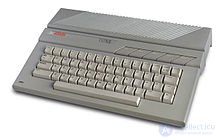
ATARI 130XE
A popular line of Atari 8-bit computers has also been developed. The new XE series was introduced at the Las Vegas Consumer Electronic Show and soon the Atari XE computers went on sale. In fact, the new Atari 65XE model was not much different from the popular Atari 800XL model, but received a new case, did not have an expensive and not very popular PBI expansion port and, most importantly, was cheaper to manufacture. And the Atari 130XE model also had twice the amount of RAM - 128 kilobytes versus 64. If last year it seemed that one of the most popular and oldest lines of home computers ceased to exist, then the output of XE computers revived the platform and extended it a life. In fact, Atari 8-bit computers were produced before 1992, and thus this gaming platform (and not only the gaming) existed on the market for about 13 years, and the last 8 years of life Atari has been selling computers from the XE series.
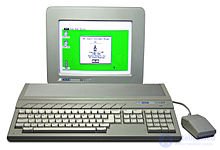
Atari 1040ST - representative of the line of computers Atari ST
Atari has been working on the development of the XE line for some time, but the new models of 8-bit computers of this company have not been released. Jack Tremela Corporation quickly switched to the creation of the next generation of computers. As you know, Tremel failed with the involvement of the new generation of the Amiga development team ( see above ) for the project to create a
продолжение следует...
Часть 1 The history of computer games
Часть 2 1983 - The history of computer games
Часть 3 1984 - The history of computer games
Часть 4 - The history of computer games
Часть 5 1991—2000 - The history of computer games
Comments
To leave a comment
Computer games developming, game-design
Terms: Computer games developming, game-design